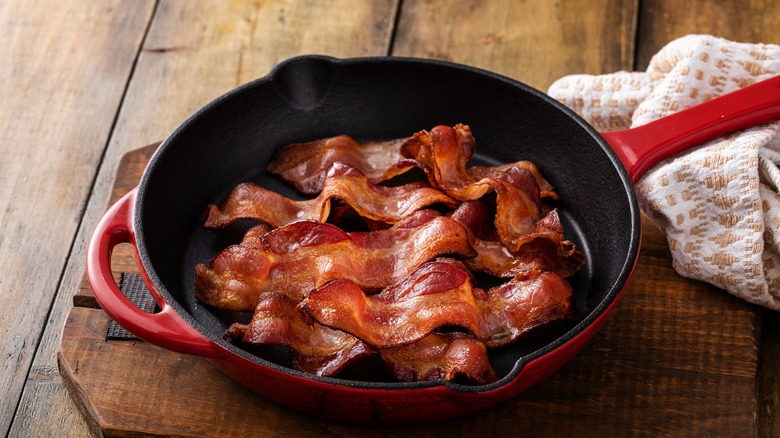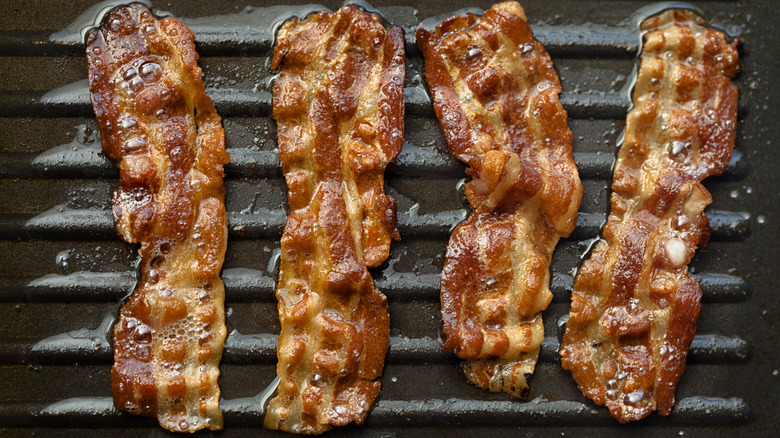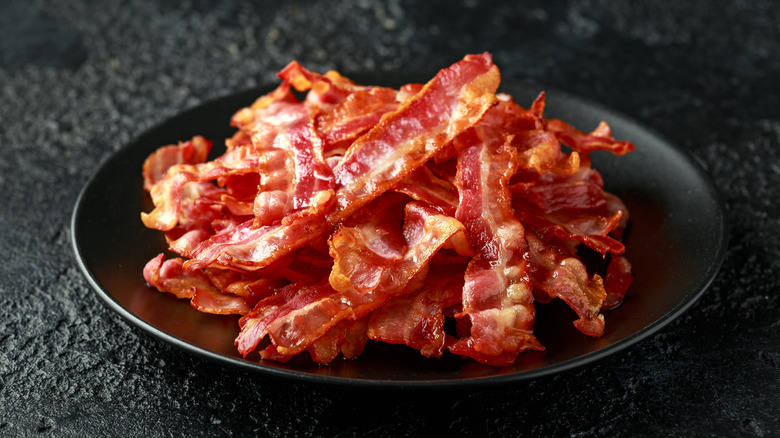Why You Should Be Cooking Bacon In A Cold Pan To Start
If you've been tossing your bacon into a sizzling hot pan all these years, don't worry, you're not alone — and it's never too late to change your ways. It's time to consider a different approach: starting your bacon in a cold pan. Low and slow isn't just for making tough pork shoulder and brisket more tender; it's also the secret to crispy bacon. The reason? Bacon fat needs time to melt ... more on that in a bit.
The cold pan method isn't a fleeting kitchen fad — it's rooted in culinary science, which is why cooking pros embrace this method. If you want to elevate your breakfast game, achieving evenly cooked, crispy bacon every time is a good place to start. (Although we might also suggest jazzing up your scrambled eggs, too.) It's a simple adjustment to your cooking routine that could make all the difference. So, let's dive into the science behind why this approach works so well.
Why slow and steady wins the bacon race
The magic of preparing bacon in a cold pan boils down to the interplay of cooking temperatures and the structure of bacon. As TikTok creator @aragusea explains, fat — the white stuff in bacon — starts to render (or melt) at a relatively low temperature, around 140 degrees Fahrenheit. On the other hand, muscle, like the red meat found in bacon and ham — begins browning at a higher temperature, above 230 degrees Fahrenheit. Considering that bacon is a fairly even mix of fat and muscle, it's crucial to cook these components harmoniously.
@aragusea A trick for cooking bacon â€" start it in a cold pan. #tiktokpartner #learnontiktok #bacon
Tossing bacon into a hot pan often leads to the meat browning too quickly, while the fat doesn't get enough time to fully render, leaving you with a somewhat soggy, unevenly cooked, and potentially burnt end product. However, when you start with a cold pan, the gradual increase in temperature allows the fat to melt first. This not only provides natural cooking fat to coat the pan but also ensures the meat cooks evenly in the rendered fat. The result? Perfectly crispy bacon without any undercooked, flabby bits.
Bonus hacks for the crispiest bacon ever
While starting with a cold pan is a game-changer, there are a few other bacon-cooking hacks worth noting. First up is the water or parboiling trick: place the bacon in a cold pan, add just enough water to cover it (but not submerge it), and then simmer on medium-high heat until the water evaporates. Then, continue cooking in the traditional way until the bacon is done to your liking.
For those who prefer a more hands-off approach, cooking bacon on a baking sheet lined with foil in the oven offers easy cleanup and evenly cooked results. Start with a cold sheet pan lined with aluminum foil, lay out your strips, and pop it in the oven. You can preheat the oven to 400 degrees Fahrenheit, or crank on the heat after you've put in the pan, just keep your eye out at the 20, rather than 25-minute mark if you planned ahead.
Just like the cold skillet hack, starting with a cold sheet pan rather than a hot one gives the bacon fat time to slowly melt and render. Each of these methods can help you achieve that coveted balance of crispy and tender in your bacon, turning an ordinary breakfast into a gourmet experience.


